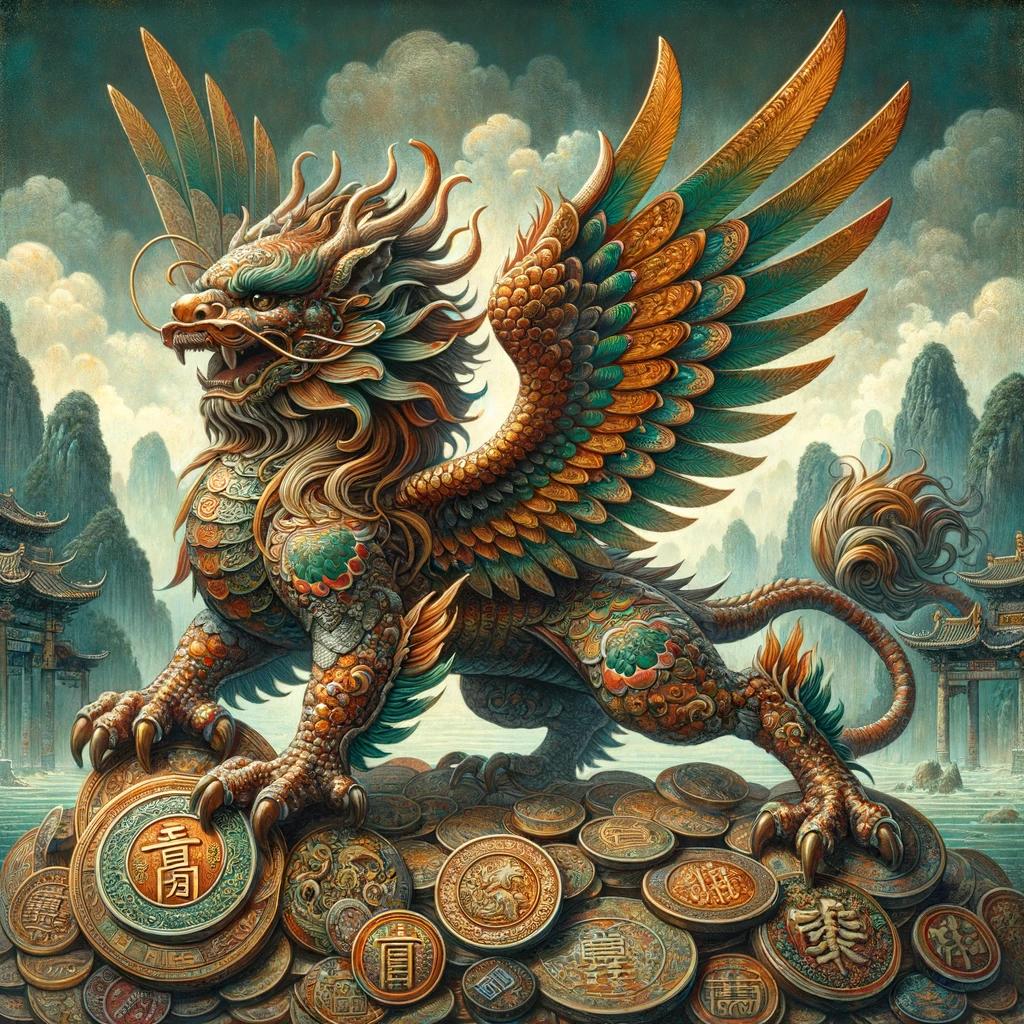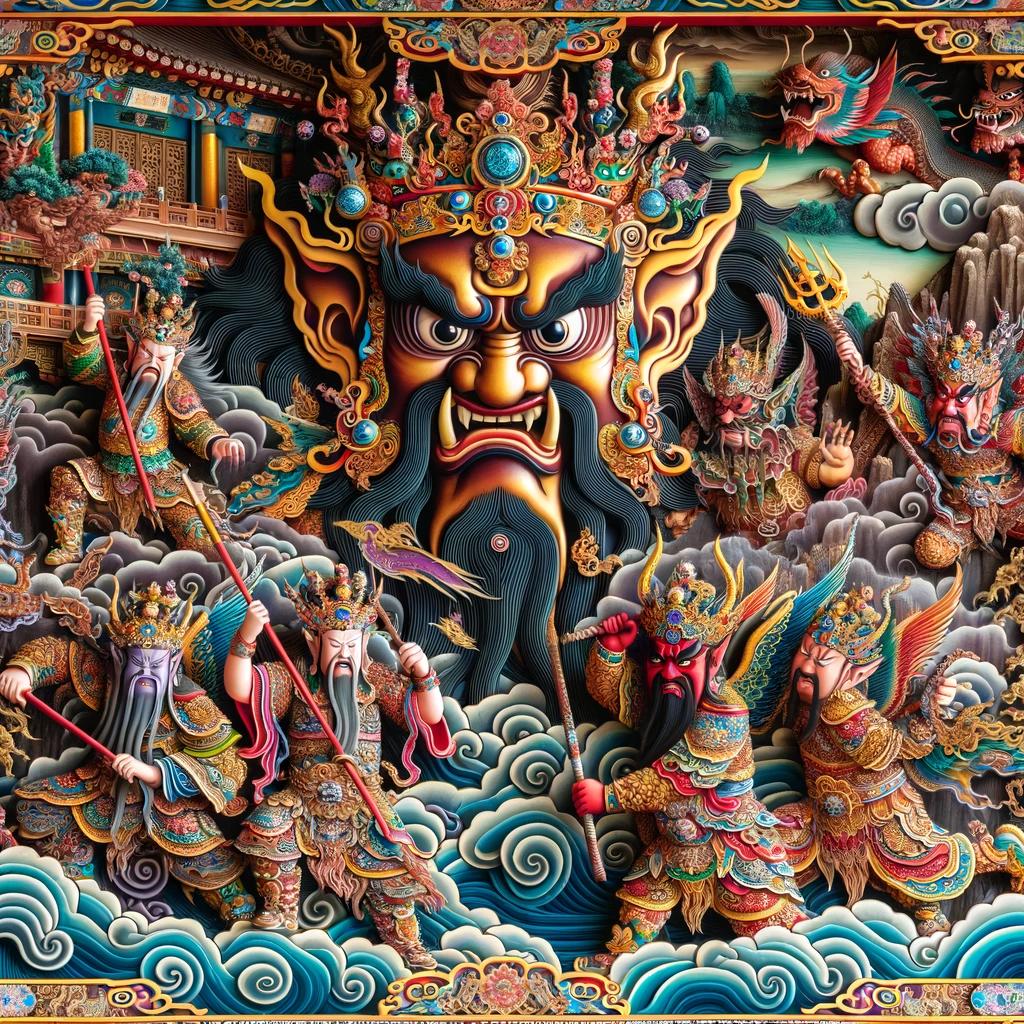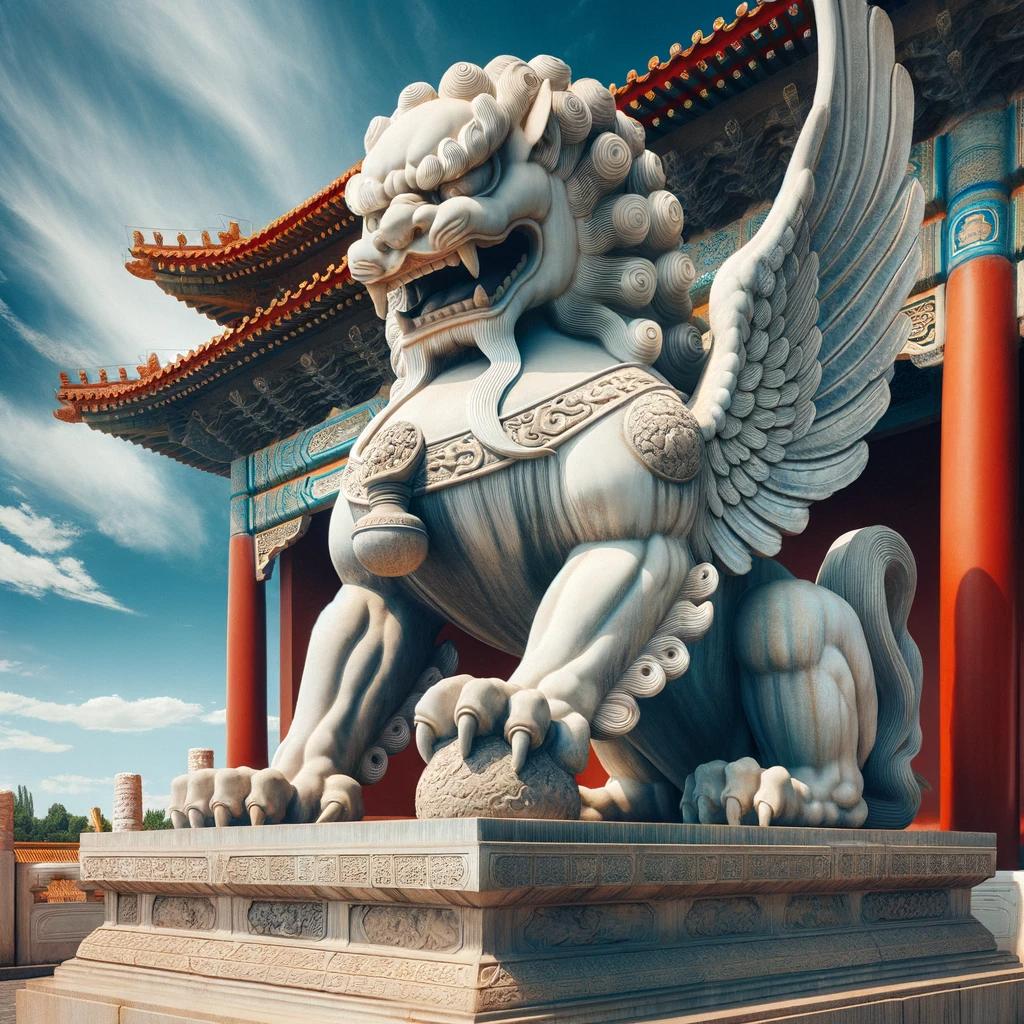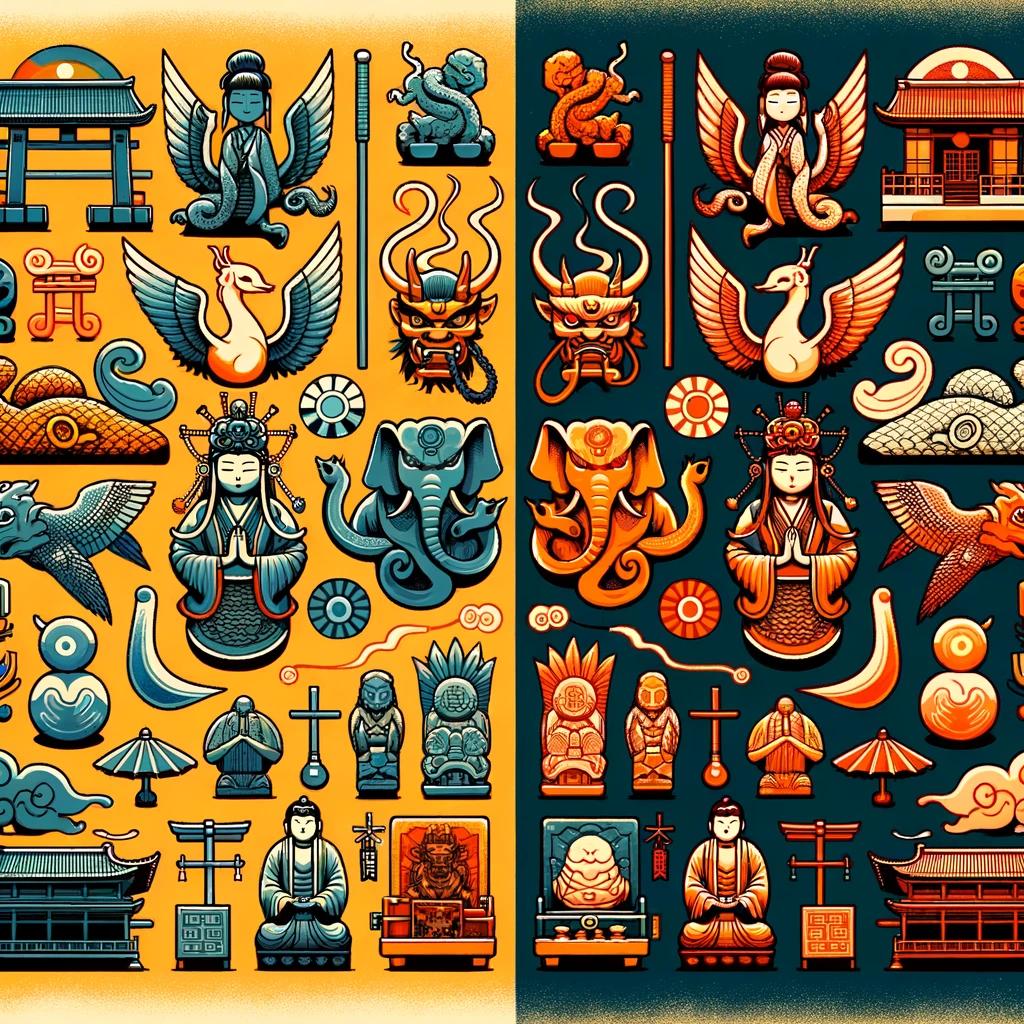Baize Chinese Mythology: Untangling the Legends
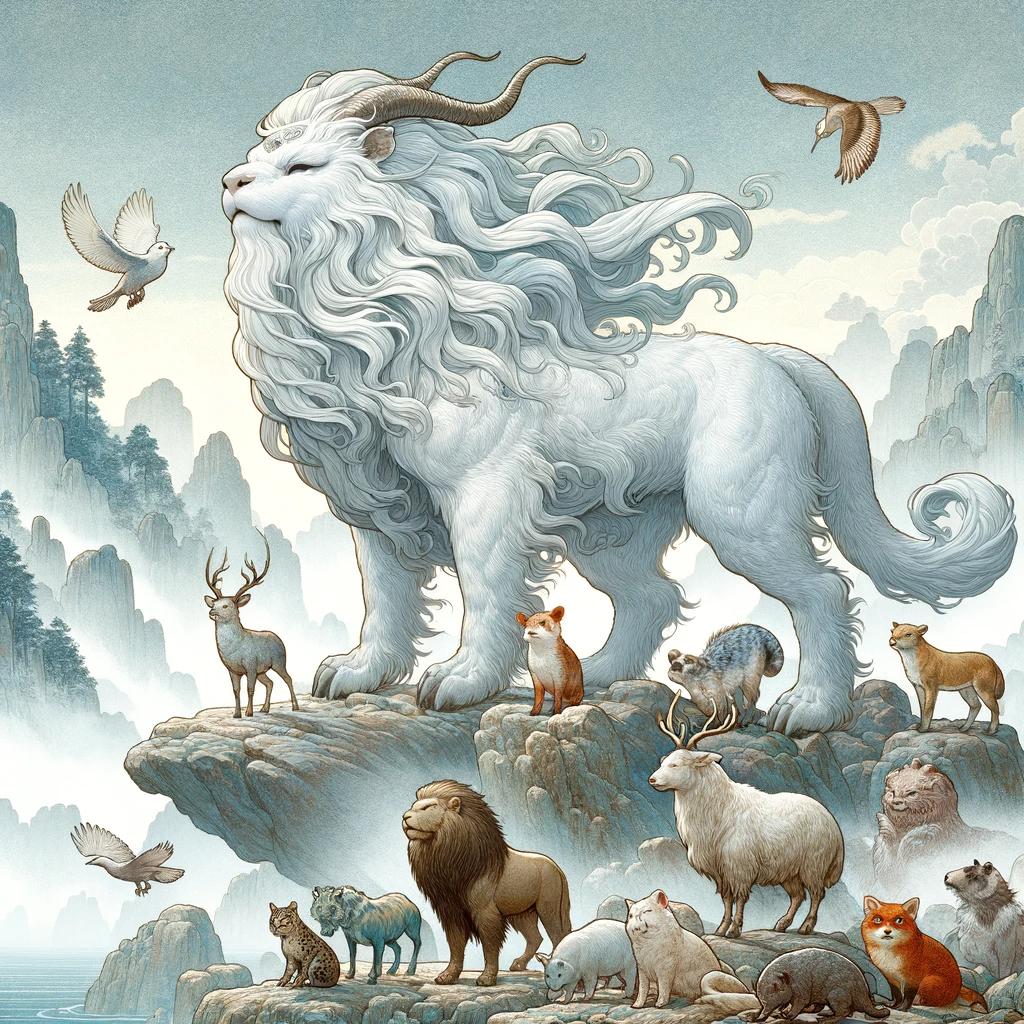
In the name of Bai Ze mythology, we explore the depths of Chinese folklore. This mythical creature, also known as Baize, is celebrated for bringing good fortune and joy to those who encounter it.
Originating from bai ze Chinese mythology, its unique appearance and vast knowledge have cemented its role in protecting against evil forces and enriching the cultural tapestry of China.
With its rich history and characteristics, Bai Ze stands as a beacon of wisdom, akin to its Japanese counterpart, the Hakutaku. This article delves into the bai ze mythical creature’s significance, stories, and symbolism within Chinese beliefs and traditions, showcasing its picture and essence in the realms of mythology.
Bai Ze: An Introduction to the Mythical Creature
Revered in Chinese mythology, the bai ze mythical creature embodies joy and good fortune. This section uncovers the bai ze beast’s origins, distinguishing it as a pivotal figure in ancient texts and folklore.
History and Origin of Bai Ze
The first mention of Baize dates back to the era of the Yellow Emperor, highlighting its sacred role in Chinese culture and mythology. As a symbol of all things good, its stories are woven into the fabric of Chinese history, embodying the wisdom and knowledge passed down through generations.
Characteristics and Appearance of Bai Ze
Evolving from a dragon to a lion-like creature with wings, the Bai Ze’s appearance reflects its celestial power to traverse heavens and protect from evil. This depiction showcases its significance in Chinese lore as a guardian and wise entity.
Bai Ze in Chinese Mythology
Baizhe is a cornerstone of Chinese mythology, offering wisdom and protection. Let’s explore the notable legends and stories that underline Baize’s mythical prominence and its role as a divine intermediary between realms.
Bai Ze’s Role in Chinese Mythology
The tales of Bai Ze, or Bai Zei, are imbued with profound wisdom and spiritual enlightenment. Its presence is a testament to the deep-rooted wisdom and guidance it provides, guarding against evil experiences and bad dreams.
Legends and Stories surrounding Bai Ze
- The Emperor Amarillo’s encounter with Bai Ze marks a pivotal moment in Chinese history, where wisdom and celestial mysteries were shared. This moment underscored Bai Ze’s role as a source of divine wisdom.
- Known for its power to ward off evil, Bai Ze is a guardian against malevolent forces, offering protection and exorcism from evil.
- As a bridge between heaven and earth, Bai Ze facilitates communication and interaction between different realms, delivering messages and wisdom.
- The profound insights and predictions of future events attributed to Bai Ze reflect the timeless wisdom of Chinese mythology, enriching cultural narratives and beliefs.
Through these stories, Bai Ze emerges as a mythical figure associated with wisdom, protection, and the interconnectivity of all things, embodying the essence of Chinese mythology.
Bai Ze and Hakutaku: Comparative Analysis
The exploration of Chinese mythology is incomplete without acknowledging Bai Ze and its Japanese counterpart, Hakutaku. This section compares these mythical creatures, highlighting their similarities and unique cultural significances.
Hakutaku: A Japanese Variation of Bai Ze
In Japanese mythology, the Hakutaku shares many traits with Bai Ze, symbolizing wisdom and knowledge. Both creatures are celebrated for their deep understanding and are revered across cultures.
Comparing the Cultural Significance of Bai Ze and Hakutaku
While Bai Ze is esteemed for its protection against evil and embodiment of wisdom, Hakutaku similarly holds a revered place in Japanese folklore, making both creatures significant in their respective mythologies.
On the other hand, Hakutaku is closely associated with the prevention of epidemics and diseases. It is believed that Hakutaku can ward off illness and bring good health to those who seek its protection.
In Japanese culture, Hakutaku is often depicted in traditional art and is considered a guardian against misfortune.
Despite these differences, both Bai Ze (白泽) and Hakutaku share the common aspect of wisdom and knowledge.
They are esteemed not just in the lore of Chinese mythology but also in Japanese beliefs, embodying the multifaceted essence of the baize mythology. These mythical entities, often depicted with the head of a lion and the body of a beast, serve as symbols of guidance and protection in their respective cultures, showcasing the deep-rooted beliefs and values of the Chinese and Japanese people.
Overall, the comparative analysis of Bai Ze and Hakutaku offers a fascinating insight into the rich mythological traditions of China and Japan. These mythical creatures, or baize as they are known in Chinese mythology, continue to captivate the imaginations of people, serving as reminders of the significance of wisdom, knowledge, and cultural heritage.
The stories and legends surrounding Bai Ze, often involving its encounters with ancient emperors and its role in warding off evil, enrich our understanding of ancient mythology.
Bai Ze in Popular Culture
Bai Ze, a mystical creature from Chinese mythology, has left a lasting impression in popular culture.
Its enigmatic nature and association with wisdom and protection have made it a fascinating subject in various artistic mediums. This section explores Bai Ze‘s influence in literature, films, art, video games, and anime, depicting it as a beacon of enlightenment amidst the shadows of evil and misfortune.
Bai Ze in Literature, Films, and Art
Bai Ze‘s presence can be found in numerous literary works that draw from Chinese mythology. Authors have been captivated by its symbolism of wisdom and knowledge, incorporating Bai Ze into their stories and poems to convey messages of enlightenment and the triumph over evil.
The creature has also made appearances in films, capturing the imagination of audience members with its unique appearance and intriguing role.
Artists have depicted Bai Ze in various forms, showcasing its majestic characteristics through intricate paintings and sculptures.
The creature’s combination of a dragon-like body, goat-like features (often portrayed as having the head of a goat with intricate horns), and wings provide artists with a diverse range of interpretations and creative expressions.
Bai Ze in Video Games and Anime
Bai Ze‘s allure extends to the realm of video games and anime, where its mythical attributes and mystical powers have become a source of inspiration for developers and creators. In video games, Bai Ze often appears as a formidable boss or a wise NPC (Non-Playable Character), offering guidance and quests to the player characters, reminiscent of its role as a purveyor of knowledge against the last remnant of evil in ancient myths.
In the world of anime and manga, Bai Ze frequently makes appearances as a mythical creature, adding depth and intrigue to captivating storylines. Its role may vary from being a guardian spirit to a source of knowledge and assistance for the protagonists, symbolizing the eternal battle against evil and the quest for wisdom.
Throughout multiple forms of popular culture, Bai Ze continues to captivate audiences, inspiring creativity and sparking the imagination of those who encounter its legendary presence.
Bai Ze: Symbolism and Beliefs
Symbolizing wisdom and knowledge, Bai Ze holds a significant place in Chinese culture and mythology.
This section explores the symbolism associated with Bai Ze, shedding light on its role as a divine creature capable of understanding dreams and evil experiences, thereby offering protection and guidance to those in need.
Bai Ze as a Symbol of Wisdom and Knowledge
Bai Ze is revered as a creature of immense wisdom and knowledge in Chinese beliefs. Its ability to communicate with all beings and understanding of the world, especially in terms of interpreting bad dreams and warding off evil experiences, make it a symbol of enlightenment and intelligence.
The legend of Bai Ze was first described in ancient texts where it was depicted as a creature with the power to see through the darkness of ignorance, thus embodying the essence of wisdom in Chinese mythology.
Considered a divine messenger, Bai Ze is often associated with the transfer of wisdom from higher realms to humanity. Its presence signifies the importance of seeking knowledge and the pursuit of intellectual growth.
Bai Ze’s Role in Warding off Evil Spirits
Beyond its association with wisdom, Bai Ze is also known for its protective qualities against malevolent forces. It is believed to possess the ability to dispel and exorcise evil spirits, safeguarding individuals from harm.
The depictions of Bai Ze are frequently seen on walls and doors as a means of warding off negativity. Its image is believed to create a harmonious and protected environment, shielding people from malicious energies.
Furthermore, historical records reveal that ancient armies featured images of Bai Ze on their banners, considering it a symbol of protection and good fortune in times of battle.
- Bai Ze represents wisdom and knowledge in Chinese culture.
- It is a divine messenger, imparting wisdom to humanity.
- Bai Ze acts as a protector, warding off evil spirits and negativity.
- Its presence is believed to bring harmony and good fortune.
- Ancient armies associated Bai Ze with protection and victory.
Bai Ze’s symbolism and beliefs have deep-rooted significance in Chinese culture, exalting the pursuit of knowledge and emphasizing the importance of protection against malevolent forces.
Bai Ze and its Connection to Chinese Culture
Bai Ze in Chinese Art and Traditions
Bai Ze holds a significant place in Chinese art and traditions, acting as both a source of inspiration and a symbol of wisdom and protection. In traditional Chinese paintings, Bai Ze is often depicted alongside other mythical creatures, celestial beings, or important figures from Chinese folklore.
These artworks showcase Bai Ze’s unique appearance, with intricate details showcasing its majestic presence.
Furthermore, Bai Ze’s image is also found in various forms of Chinese decorative arts, such as ceramics, sculptures, and textiles.
These artistic representations serve as talismans and bring good fortune, warding off evil spirits and bringing blessings to households.
Bai Ze’s influence extends beyond visual arts and is deeply intertwined with Chinese traditions.
The use of Bai Ze’s imagery in festivals, ceremonies, and rituals is prevalent throughout different regions of China. Whether it’s through the presence of Bai Ze statues or the inclusion of Bai Ze motifs in traditional costumes and accessories, this mythical creature is an integral part of Chinese cultural celebrations.
Bai Ze’s Influence on Chinese Education and Symbolism
Bai Ze’s association with wisdom and knowledge has made it a revered symbol in Chinese education. Many educational institutions, from schools to universities, incorporate Bai Ze’s image into their logos, banners, and educational materials.
This serves as a reminder for students to seek wisdom, pursue knowledge, and strive for excellence in their academic pursuits.
Beyond the educational realm, Bai Ze’s symbolism is also evident in various aspects of Chinese society.
It represents a guardian figure, protecting individuals from supernatural threats and influencing beliefs related to fortune and luck.
Moreover, Bai Ze’s influence extends to areas such as literature, where it has been referenced in Chinese classics and contemporary works.
Its presence in novels, poems, and stories adds depth and symbolism to the narratives, often highlighting themes of wisdom, enlightenment, and protection.
In summary, Bai Ze’s connection to Chinese culture is multifaceted.
It encompasses its significant presence in visual arts, traditional rituals, and decorative arts, reflecting its symbolism in wisdom, protection, and auspiciousness. Additionally, Bai Ze’s influence extends into the realm of education, serving as a reminder of the pursuit of knowledge and the importance of wisdom in Chinese society.
.













